Hello friends! Long time no write! Since most folks are social distancing it seemed like a good time to write a post I have wanted to for a while now.
The past 2 summers I have been fortunate enough to be invited to participate in Carnivale Brettanomyces. This incredible gathering of brewers, yeast lab owners and wild beer fans is held every June in Amsterdamn (sadly due to COVID-19 it has been cancelled this year). When I have finished my talks and tasting events in the Netherlands my next stop is Belgium to visit breweries that inspire me and hopefully learn more about their unqiue processes. Many of you know my sour beer epiphany moment was my first sip of the Flemish Brown “Liefmans Goudenband” 20 years ago. That beer set me on a course of learning as much as I could about sour beer: writing plus interviewing as many professional producers of these styles as I could and commericially releasing Zure Bruine. The Provisional Flemish Brown Ale I blend every few years.
In June of 2019 after Carnivale I finally had the opportunity to make the pilgrimage to the East Flanders city of Oudenaard where the storied Belgian brewery Liefmans has been located since 1697. My visit was setup to shadow one of their longtime employees for the day brewmaster Alfred. I have a great deal of information from my time with him for a much larger project, but something pretty incredible happened during my visit. A chance meeting with an amazing, tough and pioneering lady name Rosa Merckx aka Madame Rose ‘The First Female Brewmaster in Belgium’. I’d like to tell you about our time together and her importance to the world of sour beer. We did have a little help with translation during over conversation.
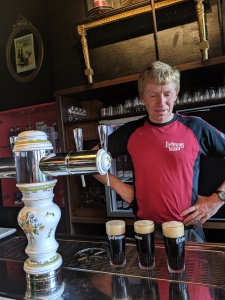 The day I visited Liefmans the entire country of Belgium was being hit with a massive heat wave pushing temps well above the normal for June. As Alfred and I begin our day we walk down the ivy lined brick buildings to their taproom alongside the river Schelde for a tasting of their core lineup of beers. You certainly need a nice refreshing baseline if you are going to talk products and process all day right? As we chat alone in the tasting room about his history at Liefmans I see a grin and he says “Oh wow you are in for a treat. Madame Rose is here.” Now as a fan of Liefmans I knew a bit about Rosa, but did not expect to meet her. She’s one of those people even at 95 years old who when they enter a room (even a room of 2 people) the room feels risen and certainly has an air of esteem.
The day I visited Liefmans the entire country of Belgium was being hit with a massive heat wave pushing temps well above the normal for June. As Alfred and I begin our day we walk down the ivy lined brick buildings to their taproom alongside the river Schelde for a tasting of their core lineup of beers. You certainly need a nice refreshing baseline if you are going to talk products and process all day right? As we chat alone in the tasting room about his history at Liefmans I see a grin and he says “Oh wow you are in for a treat. Madame Rose is here.” Now as a fan of Liefmans I knew a bit about Rosa, but did not expect to meet her. She’s one of those people even at 95 years old who when they enter a room (even a room of 2 people) the room feels risen and certainly has an air of esteem.
As Alfred introduces me to her and tells her about the purpose of my visit she immediately is served a Goudenband (pronounced How-den-bond). Her senses as sharp as ever looking at the color, smelling the batch and grining as she enjoys the first sip. “If the beer isn’t excellent I will say so…but where are you from?” she turns and asks I tell her Nashville, TN. She laughs “ahhh yes country music, it is everywhere there!” I decide this is a good time to ask for a full pour of Goudenband draft. As Alfred pours the perfect chalice of their flagship provisonal brown ale he reminds me the reason we are able to enjoy this beer in the United States is all due to Rosa’s hard work in 1972 by creating exportation avenues for Liefmans.
“If the beer isn’t excellent I will say so”- Madame Rose
“Some were good and some were just no good! Some [distributors] we exported to never paid. In America in that time you could just disappear, in Belgium you cannot, its a small country! haha” I ask her about the risks and reasoning for a small Belgian brewery to ship beer to the United States in the 1970’s. “Was this out of necessity or was there a market for these acidic ales in the US?” She quickly answers “Oh no, there was no market during that time. We could create the market. There was a group…a collective of Belgian brewers in the late 70’s and 1980’s with initatives from the Belgian government to create exportation. They would give money to export the product. But it was not so easy to do. We sent our beers to Antwerp and then had to find a ship that goes to America. Then when you one that goes to America its with people you don’t really know. If they are honest or not honest? If they work for it or not work for it. We did the same with Italy and one time it stopped, we don’t know why.”
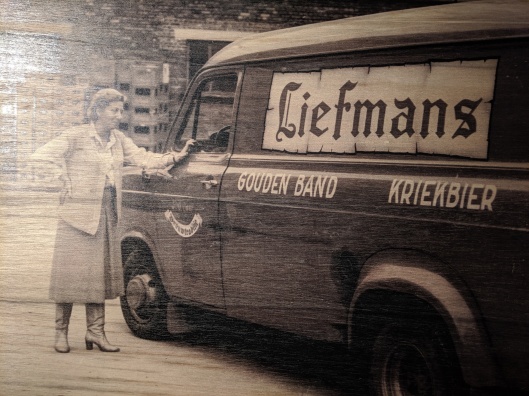
Rosa seeing off a delivery. Photo courtesy Liefmans
Rosa asks me “Do you get the dark Goudenband in Nashville?” As I tell her about Funk Fest and about how excited I was to finally serve a keg of it a few months prior I can see she is enjoying the conversation and wants to tell me something more in depth. “In this country here there were several breweries known for Belgian brown beer. There was a time when brown beer wasn’t connected to sour. Brown beer was like a Trappist or and Abbey beer, it was always non sour. So its a little different with Goudenband it was different than the others because of the sourness. This gave it more complexity. Our beers are not Guezes, its not compareable. Though our brewing is open, it has to do with atmosphere and the area in which it was made in…the infection if you want to call it in our main fermentation is spontaneous.
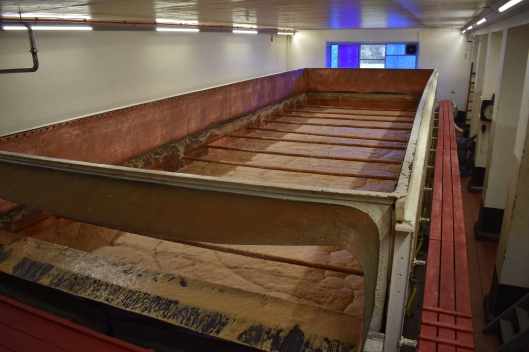
Liefmans open active fermentation vessels during transfer
But of course when you make the same beer and you have re-use of your yeast a top fermenting yeast which already has a lot of lactic acid bacteria you collect it and reuse it for the next brews you maintain this balance between bacteria and yeast. The yeast is always at the same time but is never pure yeast always contains the lactic acid. The reuse in the open vessels infect the whole area.”
Alfred nods and says “Yes the whole area will get infected by these lactic acid bacterias. A few years ago we did a few studies on what type of lactic acid bacteria is present and most of the acid here is Lactobacillus Brevis. We need them. The behavior of the bacteria is different here than other breweries. The adaptation to the environment and way of brewing.”
As we talk about the history of the recipe and if its changed the subject turns to hops and IBUS. “The hops must be good quality, you still need good hops. You must have the best ingredients otherwise you won’t have the right results. Its a better taste.” Rosa says “You can find mediocre beer anywhere. I always used Saaz, the hops are in the start of the boil for one hour and a half.” They state Goudenband is a maxium of 10 ibus.
As we finish our beers together she’s off to fill a couple jugs of local brewery water rich in calcium…but her departure home is certainly not a departure from the brewery. She has influenced so much of the process and the Liefmans character since the first day she stepped foot onto the property.
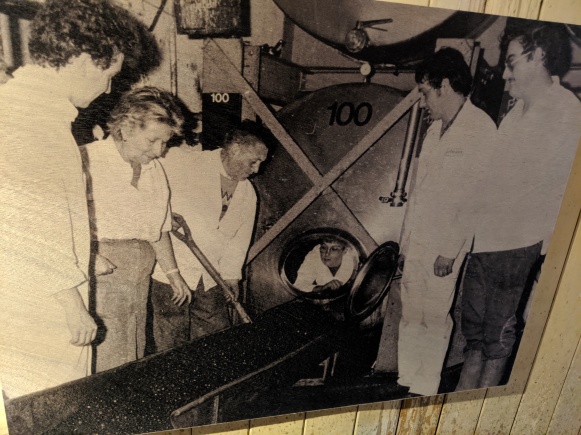
Photo courtesy Liefmans
Starting as a secretary in 1946 and bucking the “stay at home until you find a husband” mentality this pioneer of Belgian brewing thought she would try Liefmans for “maybe a month.” After all these years she tells me ” The brewery is still the most special place for me. I’m glad I did it.”
A pivotal moment for Rosa came when she was asked by her boss Mr. Vonhilenwig to try a particular beer. “What do you think of it?” he asked…With the words “I’m sorry but it’s not good, too sour (ZERP is the local term)” she changed not only the direction of the brewery but her life. The recommendations from a gifted young Rosa proved to make the beer milder, rounder with a richer more plesant taste. As time went on her work ethic and passion for brewing lead her to a larger role in the production of Liefmans beers. Taking wort density measurements, fermentations temperatures, tasting and eventually brewing together with her boss.
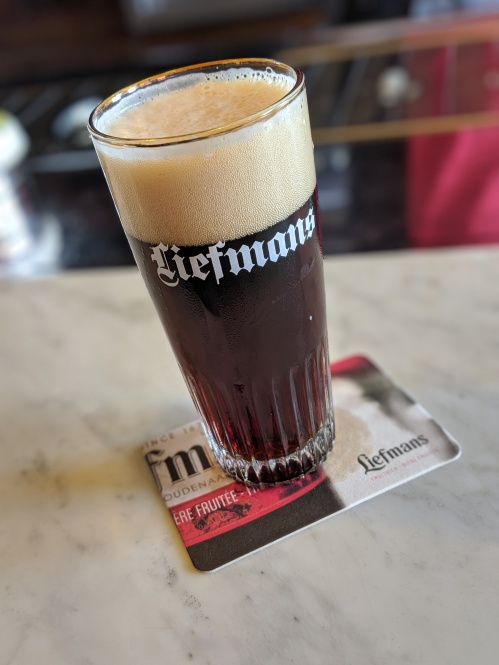
A big change for Liefman’s and another solidifaction of Rosa’s importance came around 1956/1957 when the original name for their brown ale “Azenband became challenged. [Azenband meaning the iron rings, like the rings or hoops around wood barrels.] Another gentleman at a now defunct Belgian brewery took out a patent on the name Azenband. He informed Liefmans they would be sued and owe him for every bottle of Azenband sold. Knowing that would be a huge hit to their bottom line he called to Madame Rose “This is crazy! We are not going to do that! What are we going to do?” to which she replied “Yes. What can we do? You know instead of Azenband “Iron Ring” why don’t we call it Golden Ring? Goudenband?” Mr Vonhilenwig loved the idea and said “Yes let’s go with that!” Luckily he took the proper legal steps to secure the name Goudenband cementing the name in history.

In this picture you see Madame Rose wearing the white lab coat of Mr Vonhilenwig. To feel more comfortable she would wear the coat to feel like her mentor and friend was still with her and guiding her during the daily tasks as she managed the brewery by herself. Photo courtesy Liefmans
When her boss suddenly died in 1972 Rosa became the first female Belgian Brewmaster and at the request of his family she took over the brewery until 1990 when it was purchased by Riva. In 2002 Riva was out however the brewery went broke but was revived in 2008 by current owners Duvel-Moortgat. Even though she has retired her mash paddle and stepped away from running the company make no mistake about it Rosa is very much involved in the continued development to this day tasting every new project that leaves Liefmans doors. Madame Rose a trailblazer not only in Belgian beer but her accomplishments recognized by generations of brewers looking for inspiration decades later. A truly remarkable lady whose importance in Flemish brown ale history cannot be understated.

My meeting with Madame Rose June 2019








That’s an awesome story Brandon! Thanks for sharing it. I bet that Belgium beer is full of heroes like Madame Rose.